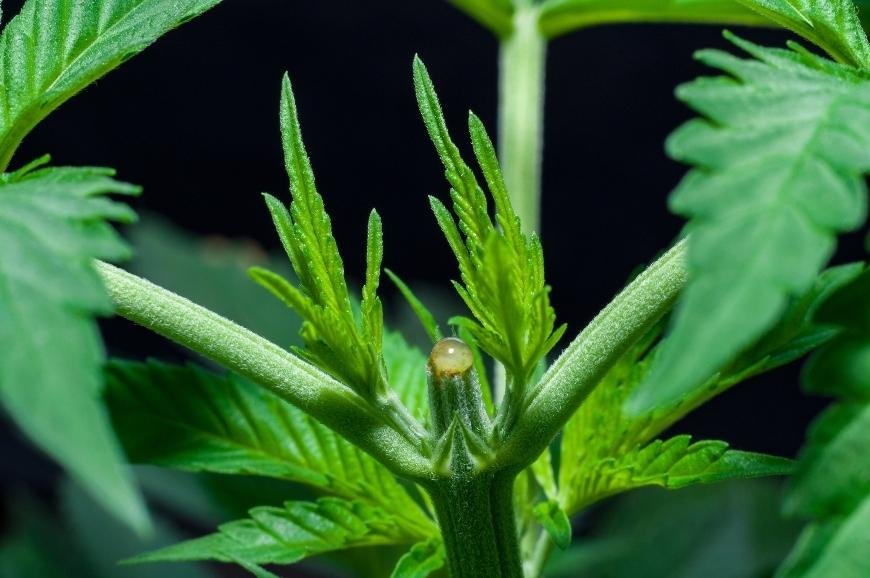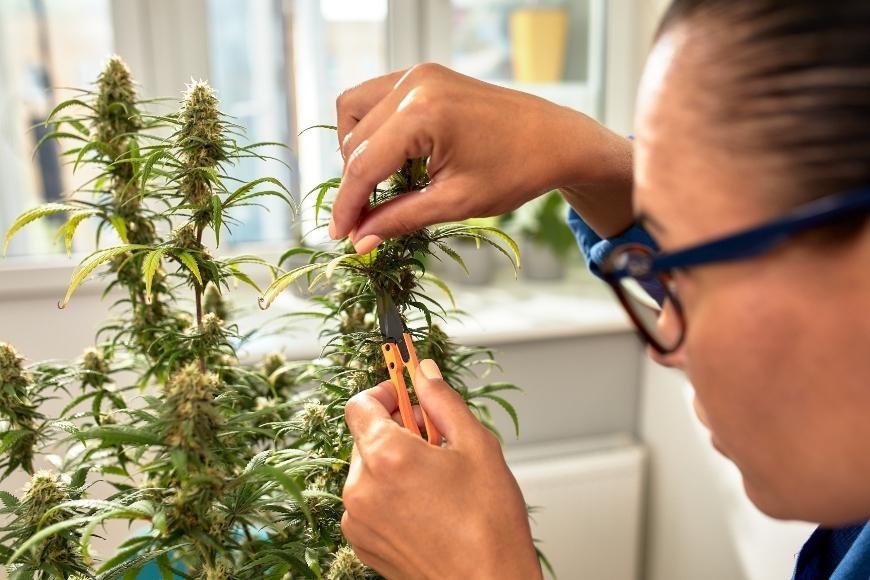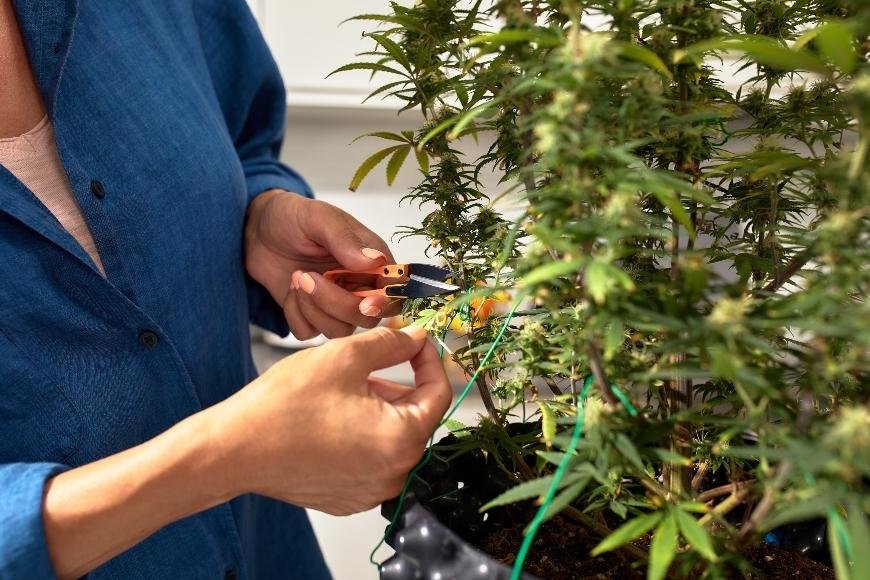Fimming Cannabis Plants: How To
Discover Fimming Cannabis Plants: How To boost your bud production with this effective green method, including tips and alternatives for a successful grow.

Mastering the art of fimming cannabis plants can significantly improve your yield and overall plant health. In this comprehensive guide on "Fimming Cannabis Plants: How To," we will delve into the intricacies of this popular technique used by experienced growers to maximize bud production.
We'll discuss what fimming is, its benefits, and how it compares to other methods such as topping cannabis. You'll learn step-by-step instructions on how to perform fimming effectively during the vegetative stage, along with tips for successful implementation and potential problems you may encounter.
Additionally, we will explore alternatives to fimming that cater to different growing preferences. By the end of this post on "Fimming Cannabis Plants: How To," you'll be well-equipped with knowledge and confidence in applying this green method for optimizing your cannabis plants' growth potential.
Table of Contents:
- What is Fimming?
- The Origin of Fimming
- Benefits of Fimming
- How to Fimm Cannabis Plants
- When to Fimm Cannabis Plants
- Tips for Successful Fimming
- Potential Problems with Fimming
- Alternatives to Fimming
- Frequently Asked Questions Fimming Cannabis Plants: How to
- Conclusion
What is Fimming?
Fimming, also known as "fuck, I missed," is a popular cannabis cultivation technique that aims to increase the overall yield and promote bushier growth in cannabis plants. This method involves carefully pinching off the new growth tips of your plant, which encourages it to grow multiple branches instead of just one.
This pruning technique has gained popularity among recreational growers due to its potential for impressive results when done correctly. However, it's essential to keep in mind that fimming can be stressful for your cannabis plants if overdone or performed incorrectly.
The Origin of Fimming
The term "fimming" originated from an accidental discovery by a grower who intended to perform another pruning technique called topping but ended up missing their mark. Instead of cutting off the entire top part of the plant as they had planned, they only removed part of it - hence the phrase "fuck, I missed." To their surprise, this mistake led to even better results than expected: more branches and increased yields.
Why Choose Fimming Over Other Pruning Techniques?
- Bushier Growth: By encouraging lateral branching through fimming, you'll end up with a bushier plant that takes full advantage of available light and space - perfect for indoor growing setups where vertical height may be limited.
- Increase Yield: More branches mean more colas (flowering sites), leading to higher yields come harvest time.
- Easier Training: Bushy plants are easier to train using techniques like Low-Stress Training (LST) or the Screen of Green (SCROG) method, which can further increase your overall yield.
While fimming may seem like a simple technique, it's crucial to understand how and when to perform this pruning method correctly. To maximize your yield, we'll explain the advantages of fimming and provide an in-depth guide to performing this technique correctly.

Benefits of Fimming
Fimming cannabis plants can offer several advantages to growers looking for a more efficient and productive way to cultivate their favorite herb. When done correctly, this technique can lead to:
- Increased yields: By encouraging the growth of multiple branches instead of just one main stem, fimming allows your plant to produce more buds per square inch. This technique can result in a greater yield; with more buds per area being produced, you'll be able to reap a larger harvest from each plant.
- Bushier plants: The process of fimming promotes lateral growth in your cannabis plants, resulting in bushier and denser foliage. A thicker canopy provides better light penetration and air circulation, which ultimately leads to healthier plants with bigger buds.
- Better use of space: With fimming, you can optimize the available growing area by training your plants horizontally rather than vertically. This is particularly useful for indoor growers who have limited vertical space or those using grow tents or cabinets.
- Easier maintenance: Bushy cannabis plants are generally easier to maintain as they require less support during flowering compared to taller ones with fewer branches. Additionally, it's simpler to keep an eye on potential issues like pests or diseases when dealing with shorter and wider specimens.
- Potential for higher potency: Since fimmed cannabis plants receive more even light distribution across all branches due their bushy structure, there's a chance that the overall cannabinoid content may increase as well - leading not only increased yield but also potentially stronger effects from consuming the harvested product.
In order for these benefits come into play though it's important ensure proper execution; otherwise negative consequences could arise such stunted growth death due stress over-pruning. Now, let's delve into the process of fimming to reap its benefits like increased yield and even growth.
How to Fimm Cannabis Plants
Fimming is a simple yet effective technique that can help you achieve bushier cannabis plants with increased yields. To ensure success, follow these step-by-step instructions on how to fimm your cannabis plants:
- Choose the right time: Make sure your plant is in its vegetative stage of growth before attempting to fimm. This typically occurs between weeks 3 and 4 after germination.
- Select the new growth tip: Locate the newest growth tip at the top of your plant, which should be easily identifiable by its lighter color and smaller size compared to older leaves.
- Pinch off the tip: Using clean fingers or sterilized scissors, gently pinch or cut about three-quarters of this new growth tip. Be careful not to remove it entirely; leaving some behind will encourage two new branches instead of one.
- Maintain proper care: After fimming, continue providing optimal growing conditions for your cannabis plants - including water, nutrients, light exposure and temperature control - as they recover from pruning stress.
Note that while successful fimming should result in two new branches emerging from where you pinched off the original growth tip within a week or so (forming what looks like an "M" shape), sometimes only one branch may develop if done incorrectly. If this happens, don't worry. You can always try again later when another suitable growth point emerges.
Tips for Clean Cuts and Minimal Stress
When fimming your cannabis plants, it's crucial to minimize stress and potential damage. Here are some tips for making clean cuts:
- Sterilize your tools: Clean scissors or pruning shears with rubbing alcohol before use to prevent the spread of bacteria and other pathogens.
- Be gentle: Pinch or cut as gently as possible to avoid causing unnecessary trauma to the plant.
- Avoid over-fimming: Fim only one growth tip at a time per plant, especially if you're new to this technique. Overdoing it can lead to excessive stress and stunted growth.
In addition, make sure you monitor your plants closely after fimming - keeping an eye out for any signs of distress such as wilting leaves or slowed growth - so that you can address any issues promptly. With proper care and attention, your fimmed cannabis plants should bounce back quickly and reward you with bushier foliage and increased yields.
When to Fimm Cannabis Plants
The best time to fimm cannabis plants is during the vegetative stage of growth. This is when your plant focuses on developing strong roots, stems, and leaves. By applying the fimming technique at this stage, you give your plant enough time to recover from any stress it may experience and allow it to develop multiple new branches that will eventually lead to a higher yield.
Finding the Right Time in Vegetative Stage
To determine if your cannabis plant is ready for fimming, look for these signs:
- New Growth: Your plant should have at least 4-6 nodes with healthy leaves before attempting fiming. This ensures that there's enough foliage present for photosynthesis after pruning.
- Healthy Plant: Make sure your cannabis plant appears vigorous and healthy. If it shows signs of nutrient deficiencies or other issues, address those problems first before proceeding with fimming.
- Adequate Lighting: Proper lighting plays a crucial role in successful recovery after fiming. Ensure that your grow space has sufficient light intensity so that the newly developed branches can thrive.
Tips on Timing Fimming Correctly
To maximize the benefits of fimming while minimizing potential risks, consider these tips when timing this pruning technique:
- Understand each phase of vegetative growth, as knowing how long each phase lasts will help you decide when exactly within this stage you should perform fiming.
- Avoid performing fiming too close to flowering since doing so may cause the plant to focus on recovering from stress rather than producing buds.
- Be prepared to provide additional support for your cannabis plants after fimming, as bushier growth can lead to heavier branches that may require staking or other forms of support.
By understanding when and how to fimm cannabis plants properly, you'll be well on your way towards achieving impressive yields and a more robust canopy. Remember that timing is key in ensuring successful results with this pruning technique.
Tips for Successful Fimming
When fimming cannabis plants, it's important to avoid overdoing it and stressing out the plant too much. Here are some tips to help you achieve successful fimming:
- Choose the right time: As mentioned earlier, the best time to fim your cannabis plants is during their vegetative stage of growth. Ensure that the cannabis plants have ample opportunity to recuperate from any distress inflicted by pruning before they transition into flowering.
- Use clean tools: Make sure that your hands or cutting tools are clean and sterilized before starting with fimming. Dirty equipment can introduce bacteria or other pathogens into the open wounds created on your plant, leading to infections or diseases.
- Avoid excessive pruning: While it might be tempting to fim multiple branches at once in hopes of getting a bushier plant faster, this can actually cause more harm than good. Over-pruning can lead to stunted growth and increased stress levels in your cannabis plants. Instead, start by fimming one branch at a time and monitor how well your plant responds before moving on.
- Maintain proper aftercare:
- After you've successfully fimmed a branch, make sure that you provide adequate care for your cannabis plants as they recover from this process. Keep an eye on watering schedules and ensure that they receive plenty of light so that new growth is encouraged.
In addition to these tips, remember that patience is key when it comes down to achieving success with fimming techniques. It may take several weeks for new branches resulting from fimming efforts become visible; however, the end result will be well worth it as you'll have a bushier, more productive cannabis plant.
By following these tips, you can maximize your chances of successful fimming. However, there are still potential problems that may arise during the process which should be taken into consideration when attempting to fim a cannabis plant.
Potential Problems with Fimming
Fimming, while an effective technique for increasing cannabis yields and promoting bushy growth, can also lead to some potential problems if not done correctly. In this section, we will explore the potential risks of fimming and how to avoid them in order to ensure healthy growth.
Stunted Growth
One of the main concerns when it comes to fimming is stunted growth. If you accidentally remove too much plant material or damage the stem during the process, your cannabis plant may experience slowed or halted growth. To prevent this issue from occurring, make sure you are using clean and sharp tools when pinching off new growth tips. Additionally, ensure that you are only removing a small portion of the tip rather than cutting through larger stems.
Plant Stress
Fimming can be stressful for your cannabis plants since it involves physically altering their structure. Over-stressing your plants by fiming too often or at inappropriate times in their life cycle can weaken them and make them more susceptible to diseases and pests. To minimize stress on your plants:
- Avoid fiming during flowering stages as it may negatively impact bud development.
- Give your plants ample time to recover between pruning sessions (at least two weeks).
- Maintain proper environmental conditions such as temperature, humidity levels, light exposure etc., throughout their lifecycle.
Infection Risk
The open wounds created by fimming can potentially expose your cannabis plants to infections caused by bacteria or fungi entering these sites. To reduce infection risk:
- Clean all tools used for fimming before each use with rubbing alcohol or another disinfectant solution.
- Maintain cleanliness in growing areas by regularly sanitizing surfaces and equipment.
- Monitor your plants closely for any signs of infection and treat promptly if detected.
Incomplete Fimming
If you don't pinch off enough plant material during the fimming process, it may result in incomplete fimming. This can lead to uneven growth patterns or even a single branch continuing to grow instead of splitting into two new branches. To avoid this issue, make sure you are accurately pinching off just the tip of the new growth without damaging surrounding leaves or stems.
By being aware of these potential problems and taking steps to prevent them, you can successfully use fimming as a technique for increasing yields and promoting bushy growth in your cannabis plants while minimizing risks associated with improper pruning practices.

Alternatives to Fimming
If you're hesitant about fimming your cannabis plants or have had issues with the technique in the past, other pruning methods can also encourage bushy growth and increased yields. One popular alternative is topping, which involves cutting off the main stem's tip, allowing for two new branches to grow from it.
Topping vs. Fimming: What's the Difference?
While both topping and fimming aim to increase yield by promoting bushier growth, they differ in how they achieve this goal. With topping, you completely remove the top of a plant's main stem just below a node, whereas fimming requires pinching off only part of the new growth tips without fully removing them. This difference results in varying outcomes:
- Growth pattern: Topping typically produces more symmetrical branching than fimming due to its cleaner cut.
- New branches: While both techniques result in additional branches, topping usually creates two new shoots while fimming can lead to three or four.
- Recovery time: Since topping removes more plant material than fimming does, it may take slightly longer for topped plants to recover from stress caused by pruning.
Selecting an Alternative Pruning Technique Based on Your Needs
To decide whether topping or another method like Low-Stress Training (LST) might be better suited for your cannabis plants' needs consider factors such as your desired outcome and skill level. For example,
- If you want a more controlled and predictable branching structure with less chance of over-pruning damage - choose topping.
- If you're looking for a gentler pruning technique that doesn't involve cutting the plant and instead focuses on manipulating its growth through bending and tying - opt for Low-Stress Training (LST).
Ultimately, it's critical to pick a pruning approach that is compatible with your level of comfort and preferred result. Experimenting with different techniques can help you find the best approach for optimizing your cannabis plants' growth.
Frequently Asked Questions Fimming Cannabis Plants: How to
How many times can I cannabis?
You can FIM cannabis multiple times, but it's generally recommended to do it no more than 2-4 times per plant. Over-fimming may stress the plant and hinder its growth. It's essential to give your plants enough time to recover between each FIM session.
How long does it take cannabis to recover from fimming?
Cannabis plants typically take about a week or two to fully recover from fimming. The recovery time depends on factors such as the strain, overall health of the plant, and growing conditions. Make sure you provide optimal care during this period for faster recovery.
What is better topping or fimming?
Both topping and fimming have their benefits; choosing one over the other depends on your desired outcome. Topping creates two main colas with more even growth distribution while fimming results in bushier plants with potentially four new colas without significantly slowing down vertical growth.
What does an underfed cannabis plant look like?
An underfed cannabis plant usually displays signs such as yellowing leaves (starting at lower leaves), slow growth rate, weak stems, and smaller buds formation. To fix this issue, ensure proper nutrient balance by following a nutrient schedule, adjusting pH levels accordingly, and monitoring soil moisture content regularly.
Conclusion
Fimming cannabis plants can be a great way to increase yield and encourage bushy growth. Though it can be advantageous to fimm cannabis plants, care must be taken as too much of this technique may cause strain on the plant. With careful attention paid to when and how you fimm your plants, though, you'll soon see impressive results from your efforts. So if you're looking for ways on how to fimm cannabis plants successfully, remember these tips: know what benefits come with fimming; understand when is best time to do so; use correct techniques while doing so; watch out for potential problems; and consider alternatives if needed.


























































































































